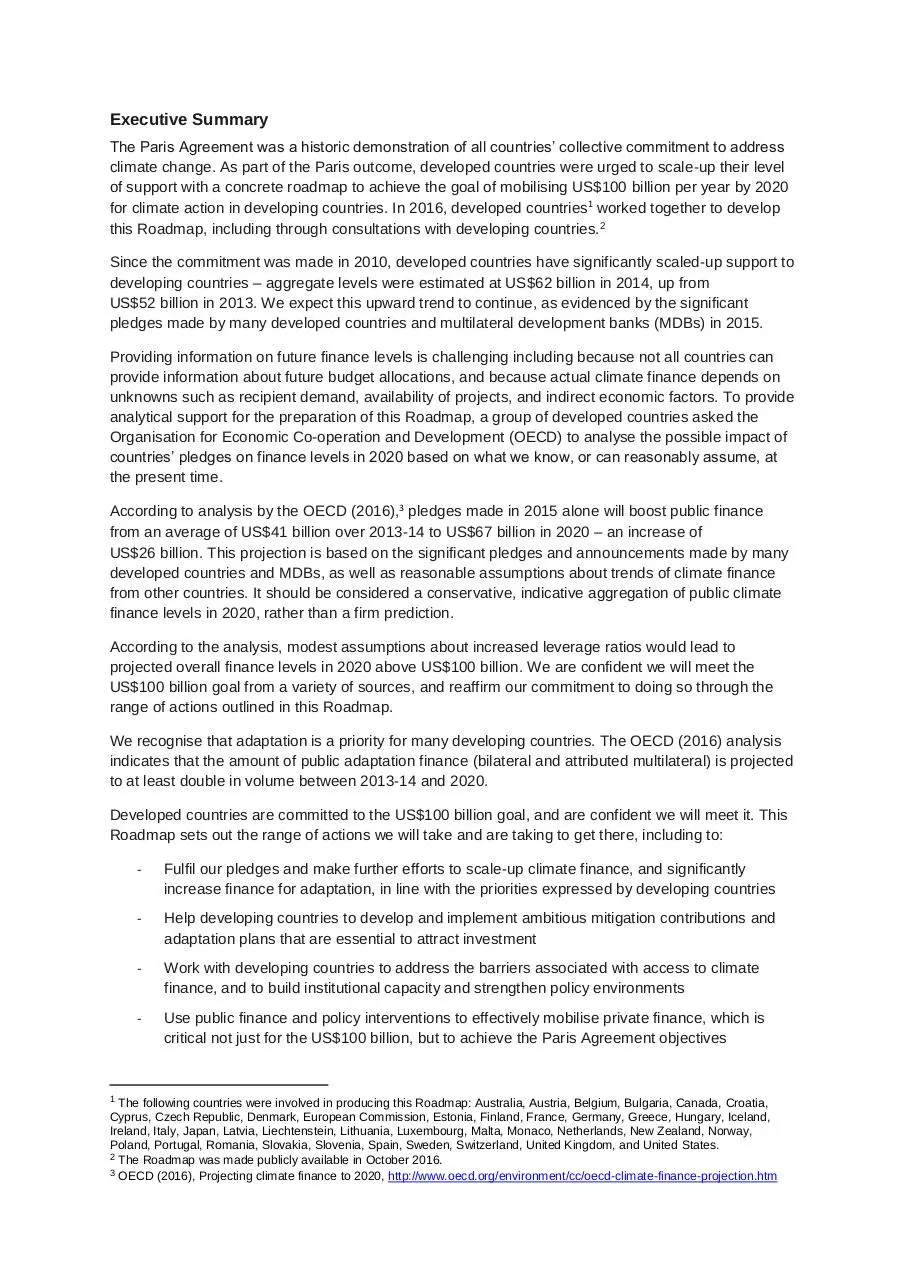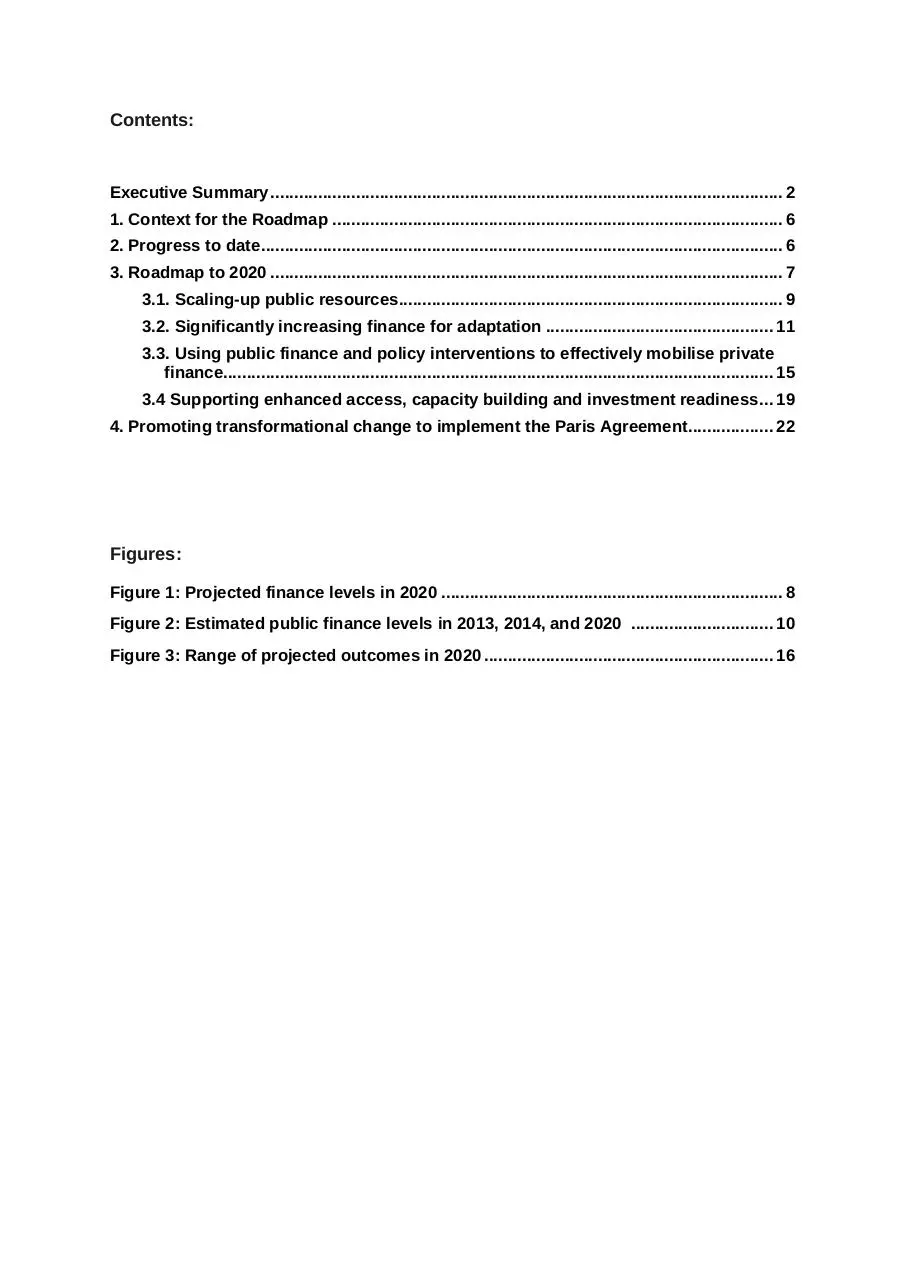climate finance roadmap to us100 billion(1) (PDF)
File information
This PDF 1.5 document has been generated by , and has been sent on pdf-archive.com on 03/06/2017 at 06:55, from IP address 66.26.x.x.
The current document download page has been viewed 477 times.
File size: 1.11 MB (27 pages).
Privacy: public file





File preview
Roadmap
to US$100 Billion
Executive Summary
The Paris Agreement was a historic demonstration of all countries’ collective commitment to address
climate change. As part of the Paris outcome, developed countries were urged to scale-up their level
of support with a concrete roadmap to achieve the goal of mobilising US$100 billion per year by 2020
for climate action in developing countries. In 2016, developed countries1 worked together to develop
this Roadmap, including through consultations with developing countries.2
Since the commitment was made in 2010, developed countries have significantly scaled-up support to
developing countries – aggregate levels were estimated at US$62 billion in 2014, up from
US$52 billion in 2013. We expect this upward trend to continue, as evidenced by the significant
pledges made by many developed countries and multilateral development banks (MDBs) in 2015.
Providing information on future finance levels is challenging including because not all countries can
provide information about future budget allocations, and because actual climate finance depends on
unknowns such as recipient demand, availability of projects, and indirect economic factors. To provide
analytical support for the preparation of this Roadmap, a group of developed countries asked the
Organisation for Economic Co-operation and Development (OECD) to analyse the possible impact of
countries’ pledges on finance levels in 2020 based on what we know, or can reasonably assume, at
the present time.
According to analysis by the OECD (2016),3 pledges made in 2015 alone will boost public finance
from an average of US$41 billion over 2013-14 to US$67 billion in 2020 – an increase of
US$26 billion. This projection is based on the significant pledges and announcements made by many
developed countries and MDBs, as well as reasonable assumptions about trends of climate finance
from other countries. It should be considered a conservative, indicative aggregation of public climate
finance levels in 2020, rather than a firm prediction.
According to the analysis, modest assumptions about increased leverage ratios would lead to
projected overall finance levels in 2020 above US$100 billion. We are confident we will meet the
US$100 billion goal from a variety of sources, and reaffirm our commitment to doing so through the
range of actions outlined in this Roadmap.
We recognise that adaptation is a priority for many developing countries. The OECD (2016) analysis
indicates that the amount of public adaptation finance (bilateral and attributed multilateral) is projected
to at least double in volume between 2013-14 and 2020.
Developed countries are committed to the US$100 billion goal, and are confident we will meet it. This
Roadmap sets out the range of actions we will take and are taking to get there, including to:
1
-
Fulfil our pledges and make further efforts to scale-up climate finance, and significantly
increase finance for adaptation, in line with the priorities expressed by developing countries
-
Help developing countries to develop and implement ambitious mitigation contributions and
adaptation plans that are essential to attract investment
-
Work with developing countries to address the barriers associated with access to climate
finance, and to build institutional capacity and strengthen policy environments
-
Use public finance and policy interventions to effectively mobilise private finance, which is
critical not just for the US$100 billion, but to achieve the Paris Agreement objectives
The following countries were involved in producing this Roadmap: Australia, Austria, Belgium, Bulgaria, Canada, Croatia,
Cyprus, Czech Republic, Denmark, European Commission, Estonia, Finland, France, Germany, Greece, Hungary, Iceland,
Ireland, Italy, Japan, Latvia, Liechtenstein, Lithuania, Luxembourg, Malta, Monaco, Netherlands, New Zealand, Norway,
Poland, Portugal, Romania, Slovakia, Slovenia, Spain, Sweden, Switzerland, United Kingdom, and United States.
2 The Roadmap was made publicly available in October 2016.
3 OECD (2016), Projecting climate finance to 2020, http://www.oecd.org/environment/cc/oecd-climate-finance-projection.htm
-
Partner with the MDBs to deliver transformational change, and work to maximise the impact
of climate funds, including the Green Climate Fund and the Global Environment Facility
-
Mainstream climate change into decision making, including development assistance, to align
efforts to address climate change and achieve the Sustainable Development Goals
-
Continue to improve tracking of climate finance, to share learnings and to understand where
we can collectively do better
The transformation to a low greenhouse gas emission and climate resilient global economy will
require efforts from all actors, beyond the scope of the US$100 billion goal. Developed countries
intend to work with all countries to accelerate this transition and achieve the Paris Agreement goals.
Contents:
Executive Summary ............................................................................................................ 2
1. Context for the Roadmap ............................................................................................... 6
2. Progress to date .............................................................................................................. 6
3. Roadmap to 2020 ............................................................................................................ 7
3.1. Scaling-up public resources................................................................................. 9
3.2. Significantly increasing finance for adaptation ................................................ 11
3.3. Using public finance and policy interventions to effectively mobilise private
finance.................................................................................................................... 15
3.4 Supporting enhanced access, capacity building and investment readiness ... 19
4. Promoting transformational change to implement the Paris Agreement.................. 22
Figures:
Figure 1: Projected finance levels in 2020 ........................................................................ 8
Figure 2: Estimated public finance levels in 2013, 2014, and 2020 .............................. 10
Figure 3: Range of projected outcomes in 2020 ............................................................. 16
1. Context for the Roadmap
In 2010, the United Nations Framework Convention on Climate Change (UNFCCC) Conference of Parties
recognised that developed country Parties committed to a goal of mobilising jointly US$100 billion per year
by 2020 from a wide variety of sources, public and private, bilateral and multilateral, including alternative
sources, to address the needs of developing countries, in the context of meaningful mitigation actions and
transparency on implementation.
2015 was a historic year, in which all countries agreed to ambitious goals to strengthen the global response
to climate change through the Paris Agreement they adopted at the UNFCCC Conference of Parties
(COP21). Achieving these goals will require a comprehensive shift in finance flows and investment patterns,
in line with the aim in Article 2.1(c) – to make finance flows consistent with low emissions and climate
resilient development pathways. The US$100 billion goal can play a catalytic role in this wider finance
landscape, and is an important measure of developed countries’ efforts to assist developing countries to
enhance their climate action.
In Paris, the UNFCCC Conference of Parties (COP21) adopted a decision strongly urging developed country
Parties to scale-up their level of financial support, with a concrete roadmap to achieve the US$100 billion
goal, while significantly increasing finance for adaptation and to further provide appropriate technology and
capacity building support.4 In keeping with the spirit of Paris, developed countries are pleased to respond to
this call with the following ‘Roadmap’.
The Roadmap aims to build confidence and provide increased predictability and transparency about the
actions developed countries are and will be taking to achieve the US$100 billion goal. The Roadmap outlines
the key factors and pathways to reach the goal, and what actions will influence progress over the remainder
of this decade. It also reflects on action developed countries are taking, together with our partners, to
transform broader finance flows and investment patterns, consistent with the goals set out in the Paris
Agreement and the Sustainable Development Agenda.
In preparing the Roadmap, we have consulted with developing country Parties and groups, multilateral
development banks (MDBs), the Green Climate Fund (GCF) and Climate Investment Funds (CIFs), as well
as non-government organisations and experts. We have also sought expert analytical support from the
Organisation for Economic Co-operation and Development (OECD). The OECD’s analytical note is available
online.5
2. Progress to date
Since 2010, developed countries have significantly scaled-up the level of financial support provided and
mobilised to developing countries. We have also made concerted efforts to improve the transparency of
climate finance so we can better understand what finance is being mobilised, where there are positive
precedents to build on, and where we can do better.
In 2015, the OECD, in collaboration with the Climate Policy Initiative (CPI), prepared a report on climate
finance mobilised towards the US$100 billion goal.6 The report was prepared at the request of the Peruvian
and French governments as the outgoing and incoming presidencies of the UNFCCC Conference of
Parties.7 It estimated that the aggregate volume of public and private climate finance mobilised by developed
countries for developing countries reached US$62 billion in 2014, up from US$52 billion in 2013.8 The
4
Paragraph 114 of decision 1.CP/21.
OECD (2016), Projecting climate finance to 2020, http://www.oecd.org/environment/cc/oecd-climate-finance-projection.htm
6 The OECD (2015) report covers the period 2013-14. It found that average finance over this period was $57 billion. As 2015 data on
finance flows are not yet available for most countries, this is the most up to date assessment as of the date of release of this Roadmap.
7 OECD (2015), “Climate finance in 2013-14 and the USD 100 billion goal”, a report by the Organisation for Economic Co-operation and
Development (OECD) in collaboration with Climate Policy Initiative (CPI), http://www.oecd.org/environment/cc/OECD-CPI-ClimateFinance-Report.htm
8 These aggregate estimates of climate finance, as well as those projected volumes in 2020 referred to in this Roadmap, do not include
finance related to coal projects. However, Japan and Australia consider that financing for high efficiency coal plants should also be
considered as a form of climate finance. In addition to the figures in the OECD (2015) report, Japan provided US$3.2 billion for such
5
6
Standing Committee on Finance’s forthcoming 2016 Biennial Assessment (BA) reports similar levels of
aggregate climate finance from developed to developing countries. The BA estimate is a slightly higher
US$53 billion in 2013, and a slightly lower US$61 billion in 2014.9
The OECD (2015) report was prepared in the context of a common understanding on the scope of mobilised
climate finance and a common methodology for tracking and reporting towards the US$100 billion goal,10
which was reached by most developed countries in 2015. The methodology aimed to enhance transparency
and consistency of reporting, and was guided by the following principles:
-
Only finance mobilised by developed country governments 11 is counted towards the US$100 billion
goal and in accounting for mobilised private climate finance, assessments are made on an activityby-activity basis, to report on private finance associated with activities where there is a clear causal
link between a public intervention and private finance, and where the activity would not have moved
forward, or moved forward at scale, in the absence of the governments’ intervention;
-
Where multiple actors are involved, the resulting finance is counted only once; and
-
The reporting framework should encourage and incentivise the most effective use of climate finance.
The OECD (2015) report provided the first insight into progress towards the US$100 billion goal, using
methodologies that were both transparent and conservative. Nevertheless, data gaps and methodological
limitations meant the picture it presented was necessarily partial. For example, finance mobilised via public
policy interventions could not be included due to a lack of available methodologies.
Developed countries are looking forward to working with all Parties to continue to improve the tracking of
climate finance in the context of our work to build an enhanced transparency framework under the Paris
Agreement. As methodological approaches evolve and data availability improves, we expect reporting to
become more complete over time including for mobilised private finance, and support received. In this
regard, we look forward to the recommendations of the 2016 Biennial Assessment. We also support efforts
by the OECD as well as the MDBs and International Development Finance Club to harmonise tracking and
reporting of climate finance through common principles.12
3. Roadmap to 2020
Developed countries are committed to collectively scaling up climate finance to meet the US$100 billion goal.
We expect the upward trend in climate finance levels from developed to developing countries to continue
over the remainder of this decade, as evidenced by the significant pledges and announcements made by the
following developed countries in 2015:
Australia, Austria, Belgium, Bulgaria, Canada, Czech Republic, Cyprus, Denmark, European
Commission, Estonia, Finland, France, Germany, Hungary, Iceland, Ireland, Italy, Japan, Latvia,
Liechtenstein, Lithuania, Luxembourg, Malta, Monaco, Netherlands, New Zealand, Norway, Poland,
Portugal, Slovenia, Spain, Sweden, Switzerland, United Kingdom, and United States.
The following MDBs also made significant climate finance pledges and announcements in 2015:
Asian Development Bank (ADB), African Development Bank (AFDB), European Investment Bank
(EIB), European Bank for Reconstruction and Development (EBRD), Inter-American Development
Bank Group (IDBG), and the World Bank Group (WBG).
projects in 2013-14. The coal-related volumes in Japan’s 2020 pledge were assumed by the OECD (2016) analysis to represent the
same percentage as in 2013-14, and this value is subtracted from the overall pledge in the projections detailed in this Roadmap.
9 The (minor) differences between the BA estimates and the OECD (2015) estimates are due to different data and methodologies being
used in some cases
10 http://www.news.admin.ch/NSBSubscriber/message/attachments/40866.pdf
11 Under the agreed methodology, private finance is attributed among all public actors involved from developed and developing
countries alike. Only the share attributable to developed country public interventions is counted towards the US$100 billion.
12 http://www.worldbank.org/en/news/press-release/2015/07/09/development-banks-common-approach-climate-finance .
7
To provide further clarity, we asked the OECD to analyse the impact of these pledges and announcements
on overall public financing levels in 2020. This analysis makes reasonable assumptions, for example to
annualise multi-year pledges, to proxy the levels of climate finance from developed countries not having
made pledges to date, and to avoid double counting between multiple sources.13 The projection uses a
methodology to attribute the developed countries’ share in each multilateral institution and fund. In order to
provide an overall sense of progress towards the US$100 billion mobilisation goal, the analysis also includes
a component relating to the levels of private finance that might be mobilised by the projected amounts of
public finance.
According to analysis by the OECD (2016), pledges made in 2015 alone will boost public finance from an
average of US$41 billion over 2013-14 to US$67 billion in 2020 – an increase of US$26 billion. This
projection is based on the significant pledges and announcements made by many developed countries and
MDBs as described above and in Table 1, as well as reasonable assumptions about trends of climate
finance from other countries.14 However, due to the challenges in predicting future levels of climate finance
(discussed further in section 3.1), and in some cases currently partial information available, the projection
should be considered a conservative, indicative aggregation of public climate finance levels in 2020, rather
than a firm prediction.
According to the analysis, modest assumptions about increased leverage ratios would lead to projected
overall finance levels in 2020 above US$100 billion. We are confident we will meet the US$100 billion goal
from a variety of sources, and reaffirm our commitment to doing so through the range of actions outlined in
this Roadmap.
Figure 1: Projected finance levels in 2020
Source: OECD (2016)
13
The OECD (2016) analysis assumes that climate finance from countries that have not made pledges or announcements about future
finance contributions will remain constant at average 2013-14 levels.
14 Over 90% of this projection is based on country and MDB pledges. The remainder is based on reasonable assumptions about climate
finance for those countries who haven't made 2020 pledges – for example, that current levels of finance are maintained.
8
Download climate-finance-roadmap-to-us100-billion(1)
climate-finance-roadmap-to-us100-billion(1).pdf (PDF, 1.11 MB)
Download PDF
Share this file on social networks
Link to this page
Permanent link
Use the permanent link to the download page to share your document on Facebook, Twitter, LinkedIn, or directly with a contact by e-Mail, Messenger, Whatsapp, Line..
Short link
Use the short link to share your document on Twitter or by text message (SMS)
HTML Code
Copy the following HTML code to share your document on a Website or Blog
QR Code to this page

This file has been shared publicly by a user of PDF Archive.
Document ID: 0000606784.